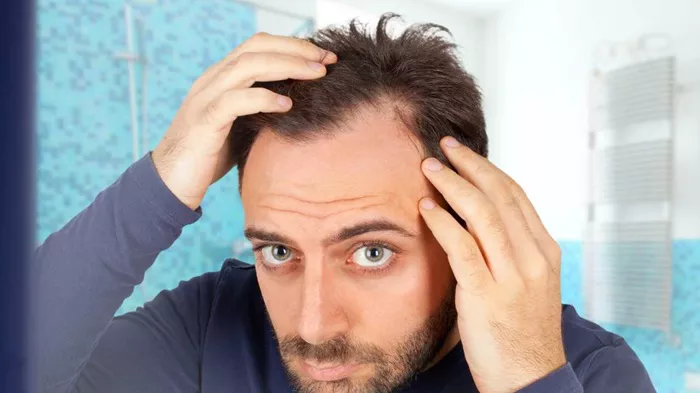Hair loss is a common concern for men, with many wondering at what age they might start experiencing it. For those typing into search engines “What Age Do Guys Start Losing Hair,” the quest for understanding male pattern baldness and its onset is apparent. To address this search intent effectively, it’s essential to provide informative, empathetic, and actionable advice. Here, we delve into the intricacies of male pattern baldness, exploring its nuances, causes, and potential solutions.
Overview of Male Pattern Baldness
Male pattern baldness, also known as androgenetic alopecia, is the most common form of hair loss in men. It’s a genetic condition that affects how hair follicles respond to androgen hormones, particularly dihydrotestosterone (DHT). Over time, the hair follicles shrink, leading to shorter and finer hair until eventually, they stop producing new hair altogether. This process typically follows a distinct pattern, starting with a receding hairline and thinning at the crown, eventually progressing to significant hair loss on the top of the scalp.
Age-Related Statistics
Understanding the age at which hair loss commonly begins can offer insight and preparedness. Statistics reveal that hair loss can commence at surprisingly young ages. Around 25% of men start to lose their hair before the age of 21, a startling realization for many young men. By age 35, approximately 66% of men will have experienced some degree of hair loss, and by age 50, a staggering 85% will have noticeable thinning or baldness.
Genetic Factors
Genetics play a significant role in male pattern baldness, with hereditary factors being the most influential determinant. If a man’s family history includes instances of male pattern baldness, there’s a higher likelihood that he will experience it himself. The inheritance pattern is complex, involving multiple genes from both maternal and paternal sides.
Signs of Balding
Recognizing the signs of balding early on can be crucial for taking proactive measures. Common indicators include a receding hairline, thinning at the crown (the top/back of the head), or a widening part. Additionally, individuals may notice increased shedding during showering or brushing, or the appearance of more scalp through the hair.
Hair Loss Patterns
Male pattern baldness typically follows one of several distinct patterns. The most recognizable is the “M” shape, characterized by a receding hairline forming the shape of the letter M. Another pattern involves thinning at the crown, leading to a circular or oval-shaped bald spot. Some men experience diffuse thinning, where hair loss occurs evenly across the scalp, resulting in a general decrease in hair density.
Causes Beyond Genetics
While genetics are the primary cause of male pattern baldness, other factors can exacerbate or accelerate the process. Stress, poor nutrition, hormonal imbalances, and certain medical conditions can all contribute to hair loss. Addressing these underlying factors through lifestyle changes or medical intervention may help slow down or mitigate hair loss progression.
Prevention and Treatment
Fortunately, several options exist for preventing or treating male pattern baldness. Over-the-counter products such as minoxidil (Rogaine) and finasteride (Propecia) have been FDA-approved for promoting hair growth and preventing further loss. Prescription medications like dutasteride and topical therapies like corticosteroids may also be recommended by healthcare professionals. In more advanced cases, surgical procedures such as hair transplantation or scalp reduction surgery offer long-term solutions.
When to See a Professional
While some degree of hair loss is natural, excessive or rapid shedding may warrant a consultation with a dermatologist or a trichologist. These specialists can evaluate the underlying causes of hair loss and recommend appropriate treatments or interventions. It’s advisable to seek professional guidance if hair loss is causing significant distress or impacting overall well-being.
Psychological Impact
The psychological impact of hair loss should not be underestimated. Many men experience feelings of self-consciousness, embarrassment, or diminished self-esteem as a result of their changing appearance. It’s essential to acknowledge these emotions and seek support when needed. Counseling, support groups, or talking openly with friends and family can help individuals cope with the emotional challenges of hair loss.
Myths vs. Facts
Dispelling common myths about hair loss can empower individuals to make informed decisions about their care. Contrary to popular belief, wearing hats does not cause baldness, nor does frequent shampooing. Hair loss is not solely a result of poor hygiene or wearing tight hairstyles. Understanding the true causes and mechanisms of hair loss can help individuals navigate treatment options more effectively.
In conclusion, male pattern baldness is a widespread condition that can begin at various ages, influenced by genetic predisposition and other contributing factors. Recognizing the signs of balding, seeking professional guidance when necessary, and exploring available prevention and treatment options are essential steps in managing hair loss effectively. By providing comprehensive information and practical advice, individuals can make informed decisions about their hair health and well-being.
you may be interested

